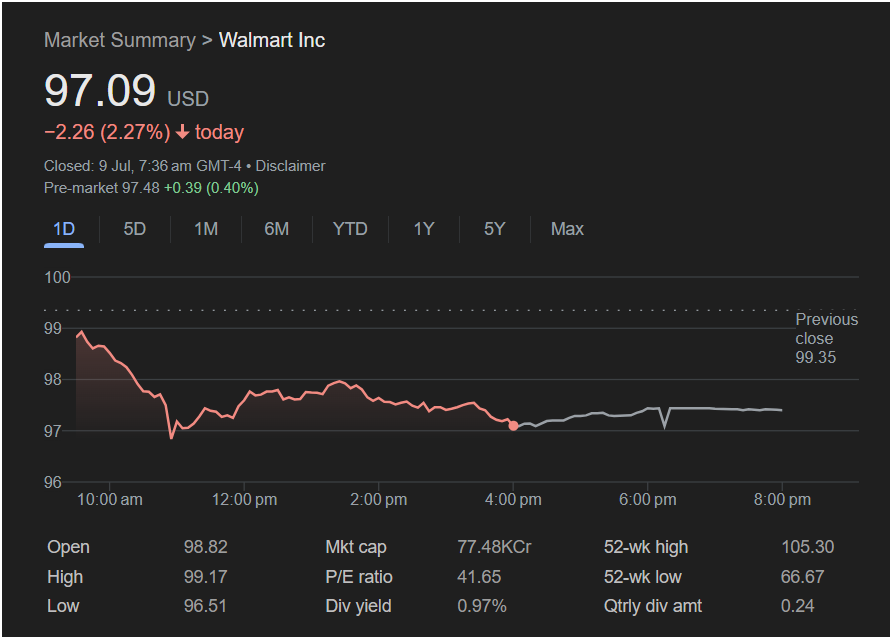Walmart Tumbles 2.27% in Heavy Sell-Off, as Profit-Taking and Consumer Jitters Spook Investors

BENTONVILLE, Ark., July 9 – Shares of retail titan Walmart Inc. (NYSE: WMT) suffered a significant setback in Tuesday’s trading, plunging as a wave of sustained selling pressure gripped the stock from the opening bell. The company, a key bellwether for the health of the American consumer, saw its stock price close at
2.26, representing a 2.27% loss for the day.
The trading session was a clear victory for the bears, with the stock opening lower and spending the entire day in negative territory. After a brief attempt to rally at the open, which saw it reach an intraday high of $99.17, the stock entered a steep slide, bottoming out at $96.51. The failure to mount a meaningful recovery from these lows underscored the bearish sentiment that dominated the day’s narrative.
This pronounced drop, coming after a period of significant strength that saw the stock trading near its all-time highs, raises critical questions about both Walmart’s lofty valuation and the underlying strength of consumer spending. However, offering a glimmer of hope for a potential rebound, pre-market data for the next session indicated a modest recovery, with the stock quoted at
0.39 or 0.40%. Nevertheless, Tuesday’s bruising session has undoubtedly put investors on high alert.
Section 1: Anatomy of a Bearish Day – A Moment-by-Moment Analysis
The day’s 2.27% decline was not a slow drift but a decisive and aggressive move to the downside. The intraday chart tells a clear story of sellers being in firm control from start to finish.
The Opening Salvo and Waterfall Decline (9:30 AM – 11:30 AM EST)
The tone for the day was set before the market even fully settled. The stock opened at
99.35. In the first few minutes of trading, there was a brief “head-fake” rally that pushed the price to its daily high of $99.17. This move, however, lacked any real conviction and was quickly and decisively rejected. It likely represented the last gasp of buy orders before the sellers took complete command.
What followed was a classic “waterfall decline.” The stock price fell sharply and persistently for the first two hours of the session. It sliced through the $98 and
96.51**.
The Anemic Bounce and Afternoon Consolidation (11:30 AM – 4:00 PM EST)
After hitting its low, the stock attempted to stage a recovery. However, this bounce was weak and choppy. For the remainder of the afternoon, Walmart’s stock traded in a tight, sideways range, mostly between $97.00 and $97.80. While it managed to lift itself off the absolute lows, it failed to reclaim any significant technical levels.
This price action is telling. A strong stock would typically see a sharp “V-shaped” recovery as dip-buyers rush in. The failure of Walmart to do so suggests that buyers were hesitant and that sellers were still present, capping any attempts at a meaningful rally. The stock essentially “flagged” bearishly throughout the afternoon, consolidating its morning losses and setting the stage for a weak close.
The Weak Close
Closing at $97.09, just 58 cents above its intraday low, is a technically bearish sign. It confirms that sellers maintained control right into the final bell. It signals that there was no late-day rush of “bargain hunters” and that the negative sentiment that plagued the stock all day persisted. This sets a cautious tone for the following sessions, despite the small bounce indicated in pre-market activity.
Section 2: The Numbers Behind the Name – A Fundamental Examination
The day’s significant drop provides an opportunity to re-examine the fundamental data that underpins Walmart’s valuation, revealing a company in the midst of a profound transformation.
Market Capitalization (Mkt cap): 77.48KCr
The market capitalization figure, listed with the Indian notation “KCr” (Thousand Crore), appears to contain a data anomaly or a platform-specific representation. A literal translation would not align with Walmart’s known valuation. Based on its closing price of
524 billion USD**.
This massive valuation solidifies Walmart’s position not just as the world’s largest retailer, but as one of the most valuable companies on the planet. Its immense scale, logistical prowess, and ubiquitous presence make it a true bellwether for the U.S. and global economy. Its performance is often seen as a direct reflection of the financial health and spending habits of the average consumer.
The Valuation Question (P/E Ratio: 41.65)
A Price-to-Earnings (P/E) ratio of 41.65 is exceptionally high for a traditional brick-and-mortar retailer and stands at the heart of the bull vs. bear debate for Walmart. Historically, retailers trade at P/E ratios in the teens or low twenties. A P/E above 40 suggests the market is pricing Walmart not as a simple grocery and general merchandise store, but as a dynamic, high-growth technology and services company.
This premium valuation is being driven by several key initiatives:
-
E-commerce Dominance: Walmart has invested billions to build a formidable e-commerce and marketplace business that directly challenges Amazon. Its success in integrating online sales with its physical store network for pickup and delivery has been a massive growth driver.
-
Walmart+: The company’s subscription service, a direct competitor to Amazon Prime, aims to lock in customer loyalty and create a recurring revenue stream.
-
Walmart Connect: This is the company’s rapidly growing digital advertising business. It leverages its vast trove of shopper data to sell high-margin ad placements to its suppliers, a business model with profit margins far exceeding those of traditional retail.
-
New Ventures: Walmart is aggressively expanding into higher-margin sectors like healthcare (Walmart Health) and financial services (ONE).
Investors are betting that these initiatives will transform Walmart’s profitability profile, justifying the high P/E. However, on days like Tuesday, this high valuation also makes the stock vulnerable to sharp pullbacks if there are any doubts about its ability to execute on this growth story.
A Modest Yield for a Transforming Giant (Dividend Yield: 0.97%)
Walmart’s dividend yield of 0.97% is modest, further reinforcing the idea that it is being valued more for growth than for income. This is supported by the quarterly dividend amount of $0.24 per share (which annualizes to $0.96). This figure reflects the company’s recent 3-for-1 stock split, which adjusted the dividend proportionally to keep the total payout consistent. While Walmart has a long history as a reliable dividend payer, the low current yield indicates that the company is retaining the majority of its earnings to reinvest in the high-growth initiatives mentioned above.
Context is Key (52-Week Range: $66.67 – $105.30)
The day’s closing price of $97.09 sits much closer to the 52-week high of $105.30 than the low of $66.67 (note: these prices are adjusted for the stock split). This is a crucial piece of context. The stock did not fall because it was already weak; it fell sharply after a powerful run-up to record highs. This suggests that the day’s sell-off was likely driven, at least in part, by significant profit-taking. Investors who rode the stock up from its lows saw the push towards all-time highs as an opportune moment to lock in substantial gains, creating heavy selling pressure.
Section 3: The Macro-Narrative – Searching for a Catalyst
Given the lack of any major company-specific news, the 2.27% plunge was likely driven by broader market forces and shifts in investor sentiment.
A Canary in the Coal Mine for Consumer Health: Walmart is the ultimate barometer of consumer spending. A sharp, decisive drop in its stock can often be a leading indicator of economic anxiety. The day’s sell-off could have been a reaction to:
-
Worrying Economic Data: A higher-than-expected inflation report, a surprisingly weak jobs number, or a drop in consumer confidence could all lead investors to sell shares of consumer-facing companies like Walmart, fearing that shoppers will tighten their belts.
-
Concerns about Discretionary Spending: While Walmart is known for its non-discretionary grocery business, a significant portion of its sales comes from higher-margin general merchandise. Fears of a consumer pullback would hit the outlook for these more profitable categories first.
Sector Rotation and Market Dynamics: On any given day, large institutional funds may rotate capital between sectors. Tuesday could have been a “risk-on” day where investors sold defensive, consumer-staple names like Walmart to buy into more aggressive sectors like technology or cyclical sectors like energy. This rotation can cause sharp moves in individual stocks even without any fundamental change in the company’s outlook.
Valuation Reset: As discussed, Walmart’s P/E ratio is high. A day of broad market weakness or a simple shift in sentiment can be all it takes for investors to decide that such a premium is no longer justified. The 2.27% drop can be seen as the market letting some of the “air” out of a richly valued stock, bringing it back to a level that feels more reasonable to some participants.
A Necessary Correction or the Start of a Trend?
Tuesday was undeniably a painful day for Walmart shareholders. The stock’s 2.27% plunge was swift and decisive, reflecting a confluence of profit-taking from all-time highs and potential concerns about the broader economic landscape. The session exposed the vulnerability that comes with a high valuation, reminding investors that even the most formidable companies are not immune to shifts in market sentiment.
However, it is crucial to maintain perspective. Walmart remains a dominant force in global retail, and its strategic transformation into a diversified technology and services company is well underway. The pre-market uptick suggests that the immediate panic may be subsiding, and dip-buyers are testing the waters.
The critical question for investors now is whether this was a healthy, one-day correction in a long-term uptrend, or the first sign of a more significant downturn. The answer will likely be found not just in Walmart’s next earnings report, but in the economic data of the coming weeks, which will paint a clearer picture of the resilience—or fragility—of the consumer that is the lifeblood of Walmart’s empire.






